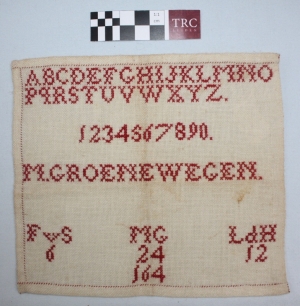The cotton ground material for marking samplers was usually an open, even-weave tabby (a form of canvas). Sometimes the samplers were cut out from a larger piece of material that was already provided with guidelines in the ground weave to indicate the right sizes.
Items to be marked with the symbols on the sampler included clothing, furnishings such as bed sheets, cushions, pillow cases, tablecloths, serviettes etc. In Northwestern Europe, in the mid- to late nineteenth century, marking samplers were usually worked in cross stitch in a red silk, and later in a cotton thread.
TRC online catalogue (retrieved 10th May 2017).
GVE

